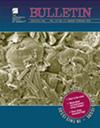Middle Devonian, late Carboniferous, and Triassic magmatic flare-ups in eastern Armorica (Sakarya Zone, Turkey) as revealed by detrital zircon U-Pb-Hf isotopic data
IF 3.7
1区 地球科学
Q1 GEOSCIENCES, MULTIDISCIPLINARY
引用次数: 0
Abstract
The Sakarya Zone of northern Turkey contains a well-preserved Early−Middle Jurassic and Late Cretaceous submarine magmatic arc constructed over pre-Jurassic bedrocks that are considered to be the eastward extension of the Armorican Terrane Assemblage in Europe. In this study, we present U-Pb-Hf isotopic data from the detrital zircons of middle Permian and Lower Jurassic sandstones to reveal episodes of Paleozoic−early Mesozoic magmatic flare-ups. Detrital zircon ages, together with data from the literature, define three major age groups at 400−380 Ma, 326−310 Ma, and 250−230 Ma, which indicates three distinct magmatic flare-ups. In addition, there are minor age clusters at 460−430 Ma and 215−195 Ma. Initial εHf values of the detrital zircons indicate significant juvenile input during the Triassic flare-up, the involvement of significantly reworked crustal material during the late Carboniferous magmatic flare-up, and both juvenile and reworked crustal material during the Middle Devonian magmatic flare-up. Within the pre-Jurassic continental basement rocks of the Sakarya Zone, the late Carboniferous igneous rocks are well documented and most voluminous, and the Middle Devonian rocks are known locally, while the Triassic igneous rocks—apart from those in Triassic accretionary complexes—are hardly known. Because the Sakarya Zone is a Gondwana-derived continental block that was later involved in the Variscan and Alpine orogenies, these magmatic flare-ups cannot be explained by subduction-related processes along a single subduction zone. We propose that the Sakarya Zone rifted from the northern margin of Gondwana during the Late Ordovician−Silurian, the Devonian magmatic flare-up (400−380 Ma) was related to the southward subduction of the Rheic Ocean beneath the Sakarya Zone during its northward drift, the late Carboniferous magmatic flare-up (326−310 Ma) occurred following the collision of the Sakarya Zone with Laurussia, and the Triassic flare-up (250−230 Ma) resulted from northward subduction of the Tethys Ocean beneath the Sakarya Zone. Comparison with data from the literature shows that the Triassic and late Carboniferous magmatic flare-ups are also characteristic features of neighboring Armorican domains, such as the Balkans and the Caucasus; however, the Middle Devonian flare-up appears to be restricted to the Sakarya Zone. Along with the late Carboniferous flare-up, the Late Ordovician−Silurian flare-up, which is locally recorded in the Sakarya Zone, is typical of the Armorican Terrane Assemblage as a whole.锆英石U-Pb-Hf同位素数据揭示的中泥盆纪、石炭纪晚期和三叠纪岩浆爆发的阿莫里卡东部(土耳其萨卡里亚区
土耳其北部的萨卡里亚区(Sakarya Zone)包含一个保存完好的早-中侏罗世和晚白垩世海底岩浆弧,该岩浆弧建造在前侏罗世基岩之上,被认为是欧洲阿莫里卡地层集合体(Armorican Terrane Assemblage)的向东延伸。在这项研究中,我们展示了来自中二叠世和下侏罗世砂岩的锆石碎片的U-Pb-Hf同位素数据,揭示了古生代-中生代早期岩浆爆发的事件。碎屑锆石年龄与文献数据相结合,确定了400-380Ma、326-310Ma和250-230Ma三个主要年龄组,表明了三次不同的岩浆爆发。此外,还有460-430 Ma和215-195 Ma的小年龄组。碎屑锆石的初始εHf值表明,在三叠纪岩浆喷发期间有大量幼生岩输入,在石炭纪晚期岩浆喷发期间有大量再加工地壳物质参与,在泥盆纪中期岩浆喷发期间既有幼生岩也有再加工地壳物质。在萨卡里亚区的前侏罗纪大陆基底岩石中,晚石炭纪火成岩有据可查,数量也最多,中泥盆纪岩石在当地也为人所知,而三叠纪火成岩--除了三叠纪增生复合体中的岩石之外--几乎无人知晓。由于萨卡里亚区是冈瓦纳派大陆块,后来又卷入了瓦里斯山造山运动和阿尔卑斯造山运动,因此这些岩浆爆发无法用沿单一俯冲带的俯冲相关过程来解释。我们认为,萨卡里亚带在晚奥陶世-志留纪从冈瓦纳北缘断裂,泥盆纪岩浆爆发(400-380Ma)与萨卡里亚带北漂过程中莱茵洋在其下方向南俯冲有关、石炭纪晚期岩浆爆发(326-310Ma)发生在萨卡里亚带与劳鲁西亚碰撞之后,而三叠纪岩浆爆发(250-230Ma)则是萨卡里亚带下的特提斯洋向北俯冲的结果。与文献数据的比较显示,三叠纪和石炭纪晚期的岩浆喷发也是巴尔干半岛和高加索地区等邻近阿莫里卡地区的特征;然而,中泥盆世的岩浆喷发似乎仅限于萨卡里亚区。与石炭纪晚期的岩浆喷发一样,萨卡里亚区局部记录的奥陶纪晚期-志留纪岩浆喷发也是整个阿莫里克地层集合体的典型特征。
本文章由计算机程序翻译,如有差异,请以英文原文为准。
求助全文
约1分钟内获得全文
求助全文
来源期刊

Geological Society of America Bulletin
地学-地球科学综合
CiteScore
9.30
自引率
8.20%
发文量
159
审稿时长
4-8 weeks
期刊介绍:
The GSA Bulletin is the Society''s premier scholarly journal, published continuously since 1890. Its first editor was William John (WJ) McGee, who was responsible for establishing much of its original style and format. Fully refereed, each bimonthly issue includes 16-20 papers focusing on the most definitive, timely, and classic-style research in all earth-science disciplines. The Bulletin welcomes most contributions that are data-rich, mature studies of broad interest (i.e., of interest to more than one sub-discipline of earth science) and of lasting, archival quality. These include (but are not limited to) studies related to tectonics, structural geology, geochemistry, geophysics, hydrogeology, marine geology, paleoclimatology, planetary geology, quaternary geology/geomorphology, sedimentary geology, stratigraphy, and volcanology. The journal is committed to further developing both the scope of its content and its international profile so that it publishes the most current earth science research that will be of wide interest to geoscientists.
 求助内容:
求助内容: 应助结果提醒方式:
应助结果提醒方式:


